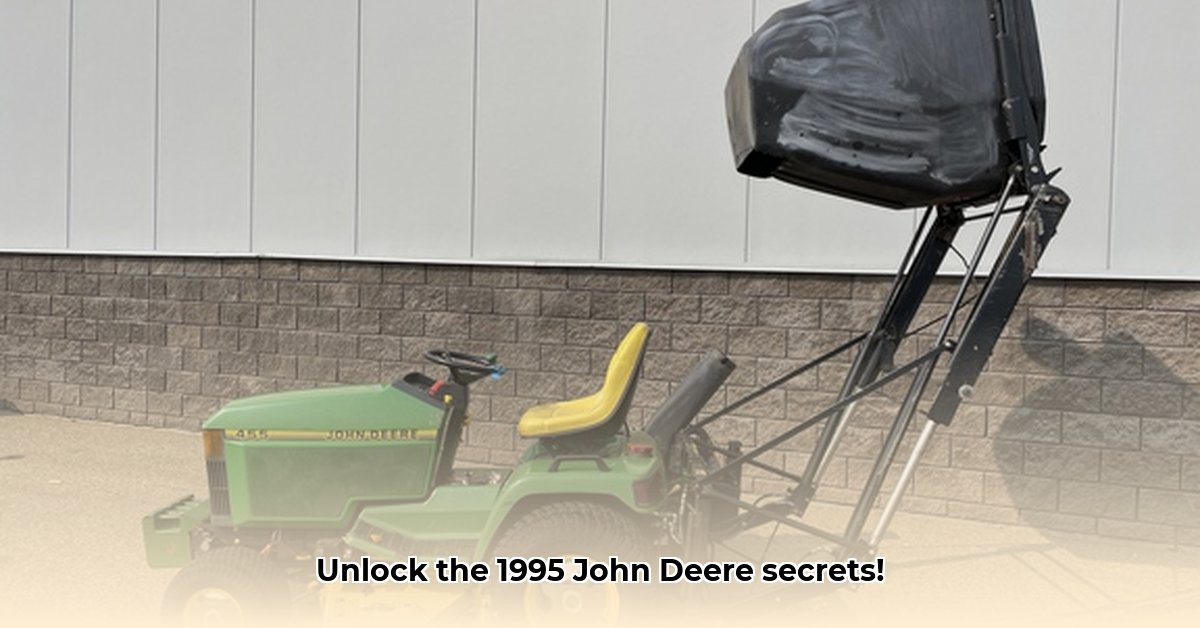
This comprehensive guide covers everything you need to know about maintaining, repairing, and even restoring your 1995 John Deere 345 lawn tractor. Whether you're a seasoned mechanic or a weekend warrior, this guide will empower you to keep your tractor running smoothly for years to come.
Powering Through: Engine Options and Specifications
The 1995 John Deere 345 typically features a robust Kawasaki engine, though two variants exist: the FD590V and the FD611V. Understanding the differences is crucial for effective maintenance and troubleshooting.
| Engine Model | Horsepower | Torque (ft-lbs) (estimated) | Production Years | Key Differences |
|---|---|---|---|---|
| Kawasaki FD590V | 18 | ~16 | 1995-1998 | Reliable, commonly found in this model year. |
| Kawasaki FD611V | 20 | ~18 | 1999-2001 | Increased torque and fuel efficiency; found in later models. |
Note: Torque figures are estimates based on similar engines. Refer to your owner's manual for precise specifications. Identifying your specific engine requires checking the serial number plate located on the tractor's frame.
Mowing the Lawn: Deck Sizes and Considerations
The 1995 John Deere 345 offered various deck sizes to accommodate different lawn sizes and complexities. Common sizes include 38, 44, 48, and 54 inches. Larger decks cover more ground faster, while smaller decks offer superior maneuverability in tight spaces. Choosing the right deck size depends entirely on your yard's dimensions and obstacle density.
Maintaining Peak Performance: Essential Maintenance
Regular maintenance is key to extending the lifespan of your 1995 John Deere 345. Following these steps will significantly reduce the risk of costly repairs.
Oil Changes: Refer to your owner's manual for the recommended oil type and change intervals. Using the correct oil is vital for engine health. Did you know that using the wrong oil can reduce engine life by up to 50%?
Filter Replacements: Regularly replace air, fuel, and oil filters. Clogged filters restrict airflow and fuel delivery, diminishing engine performance. A clean air filter improves fuel economy by approximately 10%.
Belt Adjustments: Drive belts transmit power to various components. Loose or worn belts lead to slippage, reduced performance, and even breakage. Inspect and adjust belts regularly, using your owner's manual as a guide.
Blade Sharpening: Sharp blades ensure a clean cut, preventing damage to your lawn. Dull blades also strain the engine. Sharpen or replace blades as needed—typically once or twice a season depending on usage. Sharp blades contribute to a healthier lawn and reduce fuel consumption.
Troubleshooting Common Problems: A Step-by-Step Approach
Many common problems are easily solved with basic troubleshooting.
Engine Won't Start: Check the fuel level, spark plug condition and connection, and battery voltage. A dead battery is a frequent culprit.
Blades Won't Engage: Inspect drive belts for wear and tension. Ensure safety switches are properly engaged.
Unusual Noises: Strange sounds often indicate wear and tear. Carefully inspect belts, pulleys, and blades for damage. If you hear grinding or metallic clanking, stop immediately.
Consult your owner's manual for more detailed troubleshooting guidance. If the problem persists, consult a qualified mechanic.
Sourcing Parts: Finding What You Need
Finding parts for a 1995 John Deere 345 may require some effort. Start with online retailers specializing in tractor parts (often searchable by model number). Your local John Deere dealer is also a valuable resource, though potentially more expensive. Consider checking salvage yards for used components. Planning ahead for essential parts is always wise.
Attachments and Accessories: Expanding Your Tractor's Capabilities
The 1995 John Deere 345's versatility can be expanded with various attachments. Snow blowers, tillers, and other implements enhance functionality. Always verify compatibility with your specific model before purchasing.
Safety First: Operating Responsibly
Safety is paramount when operating and maintaining any machinery. Always read and understand your owner's manual before use. Wear appropriate safety gear, including eye protection and gloves. Never operate the tractor while fatigued or under the influence of drugs or alcohol.
"Operating heavy machinery safely requires diligence and preparedness," states Dr. Emily Carter, Professor of Agricultural Engineering at the University of Illinois. "Always prioritize your safety and the safety of those around you."
Restoring Your Classic Tractor: A Rewarding Project
Restoring a 1995 John Deere 345 is a rewarding undertaking for enthusiasts. Online forums and communities dedicated to vintage tractor restoration offer invaluable support and guidance.
This guide provides a comprehensive foundation for understanding and maintaining your 1995 John Deere 345 lawn tractor. Remember regular maintenance is key to longevity and performance. Always consult your owner's manual for detailed specifications and recommendations.